A Covalently Cross-Linked Hyaluronic Acid/Carboxymethyl Cellulose Composite Hydrogel as a Potential Filler for Soft Tissue Augmentation
Abstract
:1. Introduction
2. Results and Discussion
2.1. The Design of the Protocol
2.2. The Optimization of the Composition
2.3. Fourier-Transformed Infrared (FT-IR) Analysis
2.4. Morphological SEM Evaluation
2.5. Biological Response
3. Conclusions
4. Materials and Methods
4.1. Hydrogel Preparation
4.2. Swelling Ratio
4.3. Rheological Analysis
4.4. Fourier-Transformed Infrared (FT-IR) Analysis
4.5. Morphological Analysis
4.6. Biological Resposnse
4.6.1. Cell Culture
4.6.2. Cell Viability and Morphological Assay
Author Contributions
Funding
Institutional Review Board Statement
Informed Consent Statement
Data Availability Statement
Acknowledgments
Conflicts of Interest
References
- Khalid, K.A.; Nawi, A.F.M.; Zulkifli, N.; Barkat, M.A.; Hadi, H. Aging and wound healing of the skin: A review of clinical and pathophysiological hallmarks. Life 2022, 12, 2142. [Google Scholar] [CrossRef] [PubMed]
- Heitmiller, K.; Ring, C.; Saedi, N. Rheologic properties of soft tissue fillers and implications for clinical use. J. Cosmet. Dermatol. 2021, 20, 28–34. [Google Scholar] [CrossRef] [PubMed]
- Della Sala, F.; Longobardo, G.; Lista, G.; Messina, F.; Borzacchiello, A. Effect of hyaluronic acid and mesenchymal stem cells secretome combination in promoting alveolar regeneration. Int. J. Mol. Sci. 2023, 24, 3642. [Google Scholar] [CrossRef] [PubMed]
- Della Sala, F.; di Gennaro, M.; Lista, G.; Messina, F.; Ambrosio, L.; Borzacchiello, A. Effect of Hyaluronic Acid on the Differentiation of Mesenchymal Stem Cells into Mature Type II Pneumocytes. Polymers 2021, 13, 2928. [Google Scholar] [CrossRef] [PubMed]
- Cassuto, D.; Bellia, G.; Schiraldi, C. An overview of soft tissue fillers for cosmetic dermatology: From filling to regenerative medicine. Clin. Cosmet. Investig. Dermatol. 2021, 14, 1857–1866. [Google Scholar] [CrossRef]
- Petrie, K.; Cox, C.T.; Becker, B.C.; MacKay, B.J. Clinical applications of acellular dermal matrices: A review. Scars Burn. Heal. 2022, 8, 20595131211038313. [Google Scholar] [CrossRef] [PubMed]
- Rohrich, R.J.; Ghavami, A.; Crosby, M.A. The role of hyaluronic acid fillers (Restylane) in facial cosmetic surgery: Review and technical considerations. Plast. Reconstr. Surg. 2007, 120, 41S–54S. [Google Scholar] [CrossRef]
- Sionkowska, A.; Gadomska, M.; Musiał, K.; Piątek, J. Hyaluronic acid as a component of natural polymer blends for biomedical applications: A review. Molecules 2020, 25, 4035. [Google Scholar] [CrossRef]
- Fallacara, A.; Manfredini, S.; Durini, E.; Vertuani, S. Hyaluronic acid fillers in soft tissue regeneration. Facial Plast. Surg. 2017, 33, 087–096. [Google Scholar] [CrossRef]
- Damiano Monticelli, V.; Mocchi, R.; Rauso, R.; Zerbinati, U.; Cipolla, G.; Zerbinati, N. Chemical characterization of hydrogels crosslinked with polyethylene glycol for soft tissue augmentation. Open Access Maced. J. Med. Sci. 2019, 7, 1077. [Google Scholar]
- Fundarò, S.P.; Salti, G.; Malgapo, D.M.H.; Innocenti, S. The rheology and physicochemical characteristics of hyaluronic acid fillers: Their clinical implications. Int. J. Mol. Sci. 2022, 23, 10518. [Google Scholar] [CrossRef] [PubMed]
- Wende, F.J.; Gohil, S.; Mojarradi, H.; Gerfaud, T.; Nord, L.I.; Karlsson, A.; Boiteau, J.-G.; Kenne, A.H.; Sandström, C. Determination of substitution positions in hyaluronic acid hydrogels using NMR and MS based methods. Carbohydr. Polym. 2016, 136, 1348–1357. [Google Scholar] [CrossRef] [PubMed]
- Faivre, J.; Pigweh, A.I.; Iehl, J.; Maffert, P.; Goekjian, P.; Bourdon, F. Crosslinking hyaluronic acid soft-tissue fillers: Current status and perspectives from an industrial point of view. Expert Rev. Med. Devices 2021, 18, 1175–1187. [Google Scholar] [CrossRef] [PubMed]
- Daminato, E.; Bianchini, G.; Causin, V. New Directions in Aesthetic Medicine: A Novel and Hybrid Filler Based on Hyaluronic Acid and Lactose Modified Chitosan. Gels 2022, 8, 326. [Google Scholar] [CrossRef] [PubMed]
- Tang, S.; Chi, K.; Xu, H.; Yong, Q.; Yang, J.; Catchmark, J.M. A covalently cross-linked hyaluronic acid/bacterial cellulose composite hydrogel for potential biological applications. Carbohydr. Polym. 2021, 252, 117123. [Google Scholar] [CrossRef] [PubMed]
- Gopinath, V.; Kamath, S.M.; Priyadarshini, S.; Chik, Z.; Alarfaj, A.A.; Hirad, A.H. Multifunctional applications of natural polysaccharide starch and cellulose: An update on recent advances. Biomed. Pharmacother. 2022, 146, 112492. [Google Scholar] [CrossRef]
- Varma, D.M.; Gold, G.T.; Taub, P.J.; Nicoll, S.B. Injectable carboxymethylcellulose hydrogels for soft tissue filler applications. Acta Biomater. 2014, 10, 4996–5004. [Google Scholar] [CrossRef]
- Leonardis, M.; Palange, A.; Dornelles, R.F.; Hund, F. Use of cross-linked carboxymethyl cellulose for soft-tissue augmentation: Preliminary clinical studies. Clin. Interv. Aging 2010, 5, 317–322. [Google Scholar] [CrossRef]
- Malson, T.; Lindqvist, B.L. Gel of Crosslinked Hyaluronic Acid for Use as a Vitreous Humor Substitute. US4716154A, 29 December 1987. [Google Scholar]
- De Boulle, K.; Glogau, R.; Kono, T.; Nathan, M.; Tezel, A.; Roca-Martinez, J.-X.; Paliwal, S.; Stroumpoulis, D. A review of the metabolism of 1, 4-butanediol diglycidyl ether-crosslinked hyaluronic acid dermal fillers. Dermatol. Surg. 2013, 39, 1758–1766. [Google Scholar] [CrossRef]
- Jeong, C.H.; Yune, J.H.; Kwon, H.C.; Shin, D.-M.; Sohn, H.; Lee, K.H.; Choi, B.; Kim, E.S.; Kang, J.H.; Kim, E.K. In vitro toxicity assessment of crosslinking agents used in hyaluronic acid dermal filler. Toxicol. In Vitro 2021, 70, 105034. [Google Scholar] [CrossRef]
- Lawal, O.S.; Yoshimura, M.; Fukae, R.; Nishinari, K. Microporous hydrogels of cellulose ether cross-linked with di-or polyfunctional glycidyl ether made for the delivery of bioactive substances. Colloid Polym. Sci. 2011, 289, 1261–1272. [Google Scholar] [CrossRef]
- Makvandi, P.; Della Sala, F.; di Gennaro, M.; Solimando, N.; Pagliuca, M.; Borzacchiello, A. A Hyaluronic Acid-Based Formulation with Simultaneous Local Drug Delivery and Antioxidant Ability for Active Viscosupplementation. ACS Omega 2022, 7, 10039–10048. [Google Scholar] [CrossRef] [PubMed]
- Ghazali, S.R.; Kubulat, K.; Isa, M.; Samsudin, A.; Khairul, W.M. Contribution of methyl substituent on the conductivity properties and behaviour of CMC-alkoxy thiourea polymer electrolyte. Mol. Cryst. Liq. Cryst. 2014, 604, 126–141. [Google Scholar] [CrossRef]
- Manju, S.; Sreenivasan, K. Conjugation of curcumin onto hyaluronic acid enhances its aqueous solubility and stability. J. Colloid Interface Sci. 2011, 359, 318–325. [Google Scholar] [CrossRef] [PubMed]
- Li, X.; Ke, J.; Wang, J.; Kang, M.; Wang, F.; Zhao, Y.; Li, Q. Synthesis of a novel CO 2-based alcohol amine compound and its usage in obtaining a water-and solvent-resistant coating. RSC Adv. 2018, 8, 8615–8623. [Google Scholar] [CrossRef] [PubMed]
- Chang, L.; Zhang, J.; Jiang, X. Comparative Properties of Hyaluronic Acid Hydrogel Cross-linked with 1, 4-Butanediol Diglycidyl Ether Assayed Using a Marine Hyaluronidase. IOP Conf. Ser.: Mater. Sci. Eng. 2019, 493, 012007. [Google Scholar] [CrossRef]
- Guarino, V.; Altobelli, R.; della Sala, F.; Borzacchiello, A.; Ambrosio, L. Alginate processing routes to fabricate bioinspired platforms for tissue engineering and drug delivery. Alginates Their Biomed. Appl. 2018, 11, 101–120. [Google Scholar]
- Borzacchiello, A.; Della Sala, F.; Ambrosio, L. Rheometry of polymeric biomaterials. In Characterization of Polymeric Biomaterials; Elsevier: Amsterdam, The Netherlands, 2017; pp. 233–253. [Google Scholar]
- Bahcecioglu, G.; Hasirci, N.; Hasirci, V. Effects of microarchitecture and mechanical properties of 3D microporous PLLA-PLGA scaffolds on fibrochondrocyte and L929 fibroblast behavior. Biomed. Mater. 2018, 13, 035005. [Google Scholar] [CrossRef]
- Iso, B.; STANDARD, B. Biological evaluation of medical devices. Biomed. Saf. Stand 1996, 26, 54. [Google Scholar]
- Andrade del Olmo, J.; Pérez-Álvarez, L.; Sáez Martínez, V.; Benito Cid, S.; Pérez González, R.; Vilas-Vilela, J.L.; Alonso, J.M. Drug delivery from hyaluronic Acid–BDDE injectable hydrogels for antibacterial and anti-inflammatory applications. Gels 2022, 8, 223. [Google Scholar] [CrossRef]
- Xue, Y.; Chen, H.; Xu, C.; Yu, D.; Xu, H.; Hu, Y. Synthesis of hyaluronic acid hydrogels by crosslinking the mixture of high-molecular-weight hyaluronic acid and low-molecular-weight hyaluronic acid with 1, 4-butanediol diglycidyl ether. RSC Adv. 2020, 10, 7206–7213. [Google Scholar] [CrossRef] [PubMed]
- Yang, B.; Guo, X.; Zang, H.; Liu, J. Determination of modification degree in BDDE-modified hyaluronic acid hydrogel by SEC/MS. Carbohydr. Polym. 2015, 131, 233–239. [Google Scholar] [CrossRef] [PubMed]
- Mezger, T. The Rheology Handbook: For Users of Rotational and Oscillatory Rheometers; Vincenz Network: Hanover, Germany, 2020. [Google Scholar]
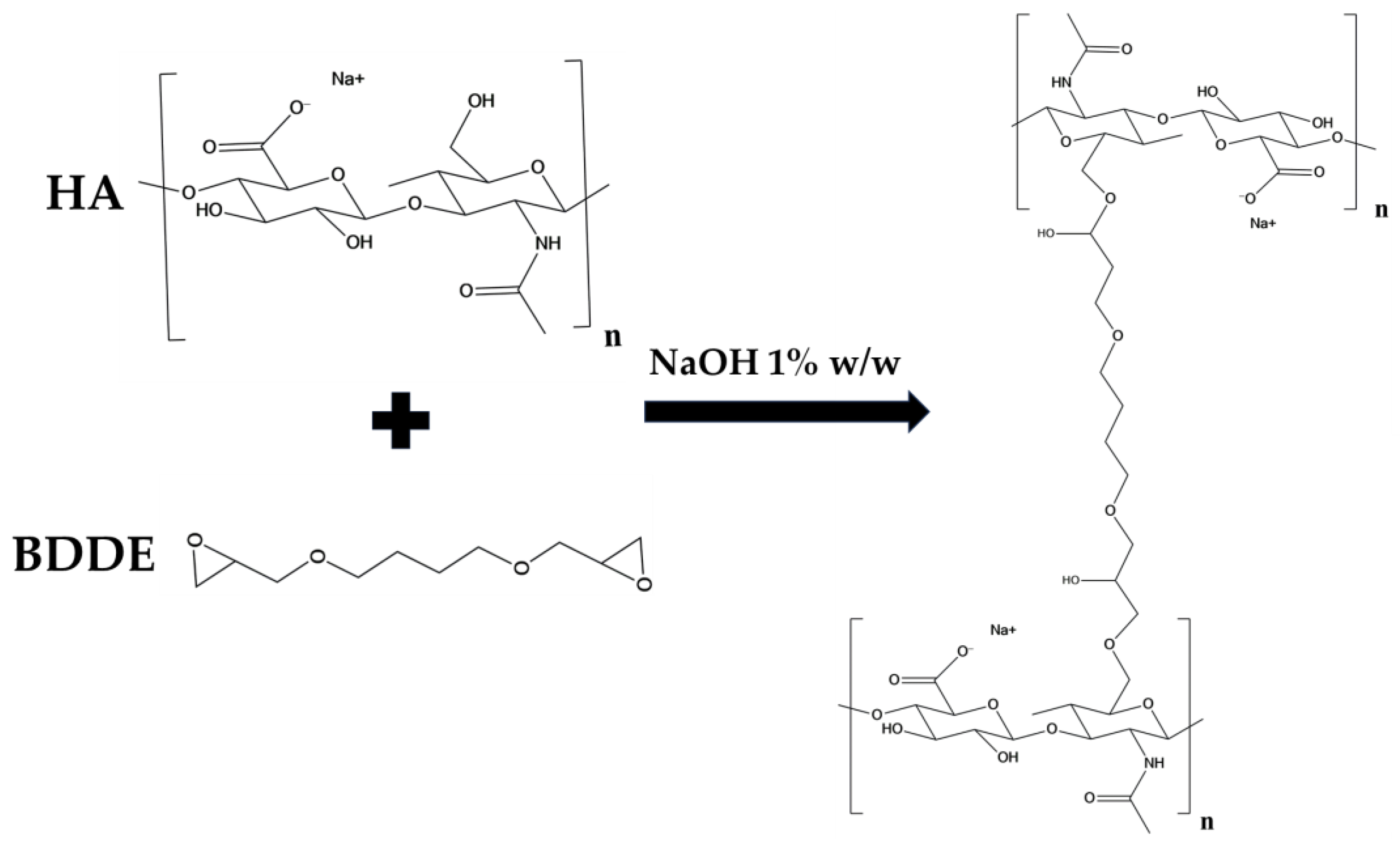

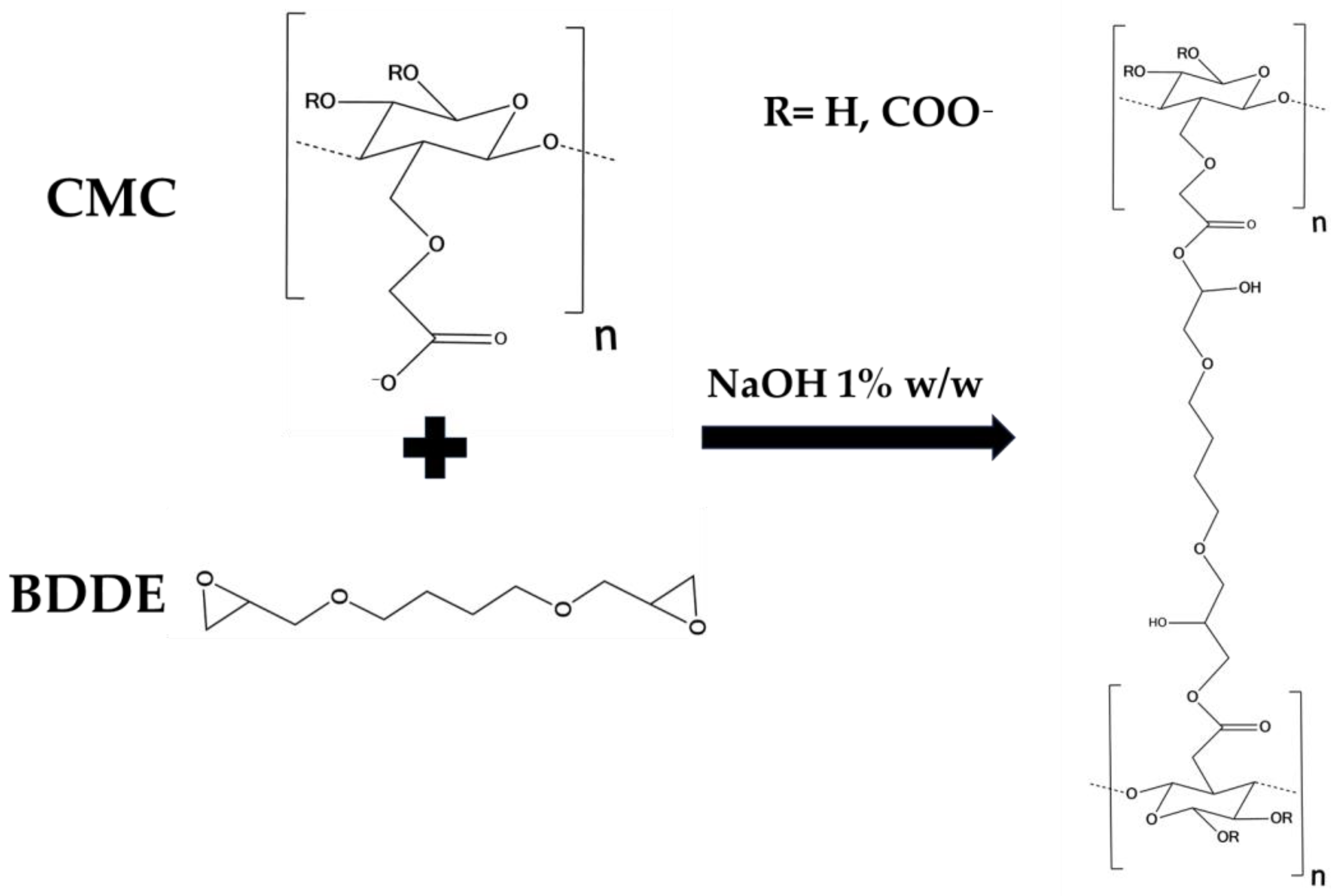

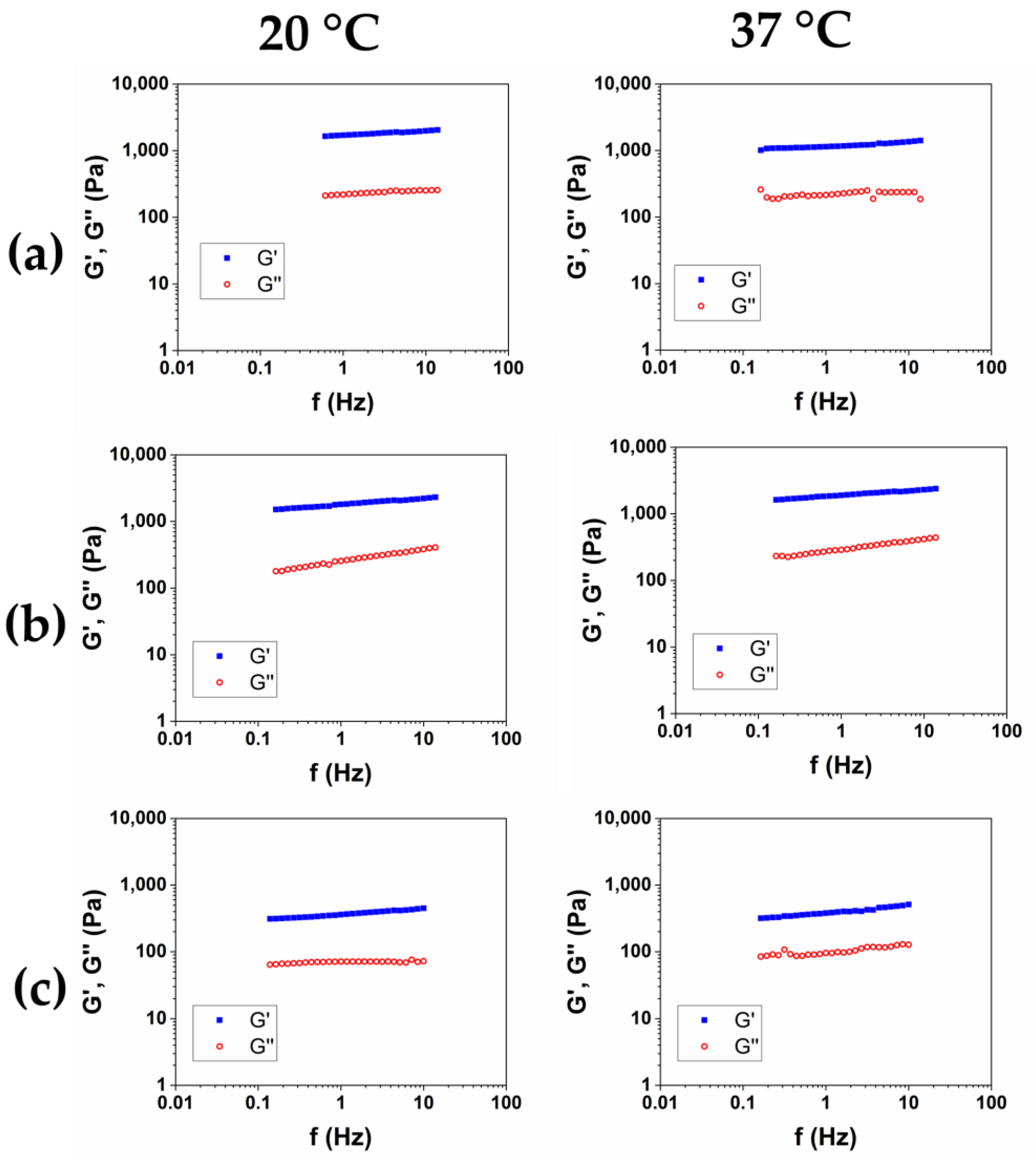
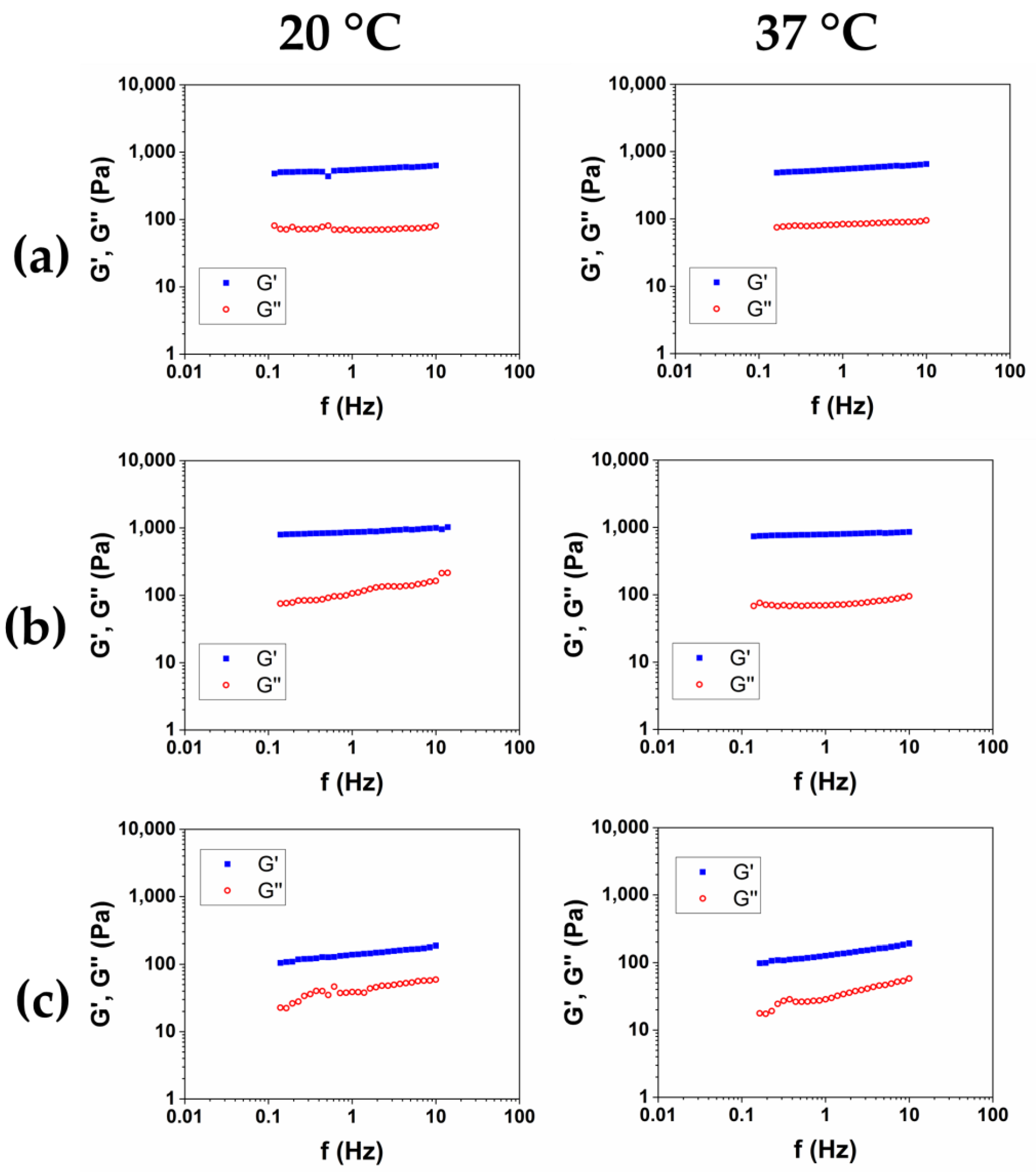
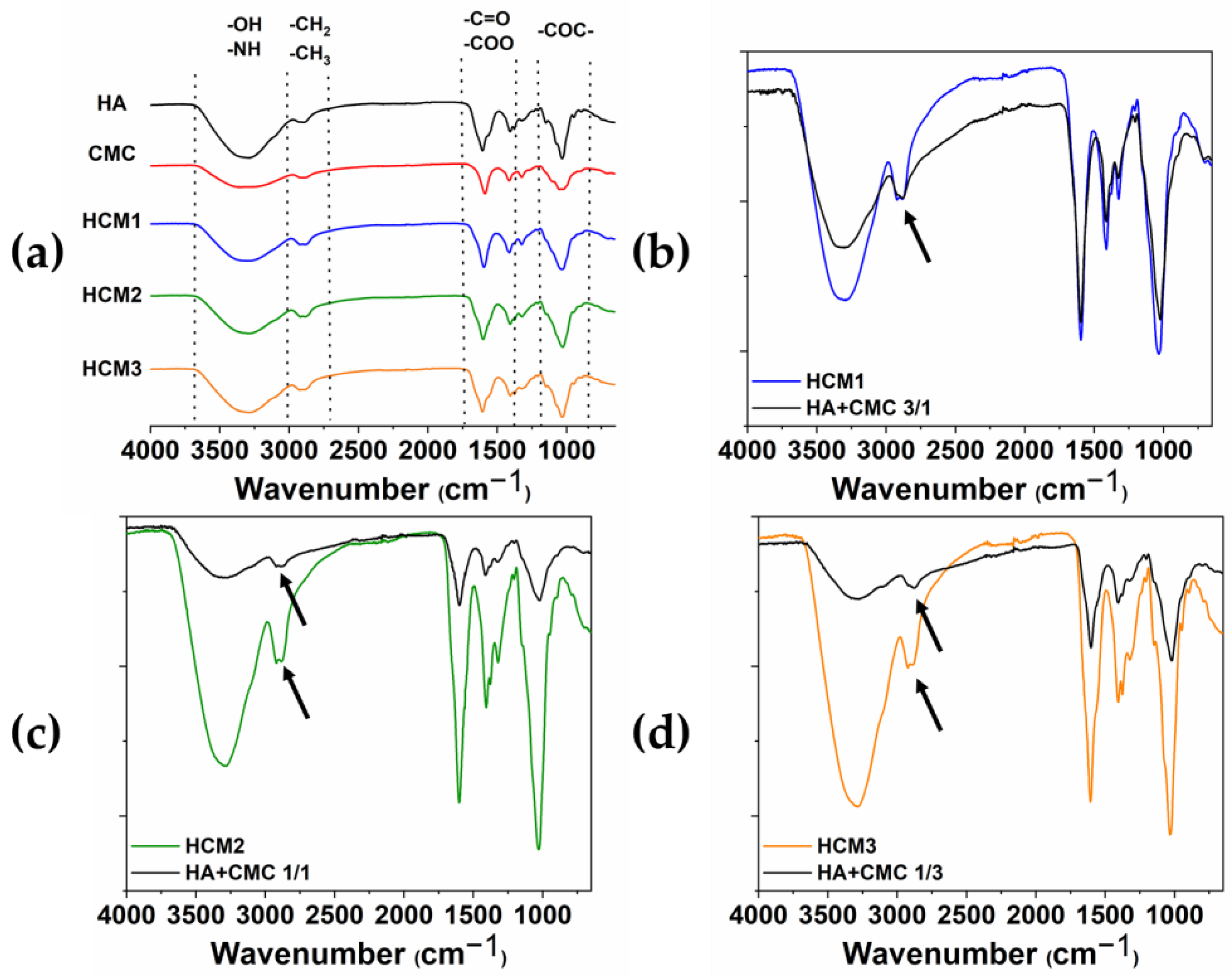

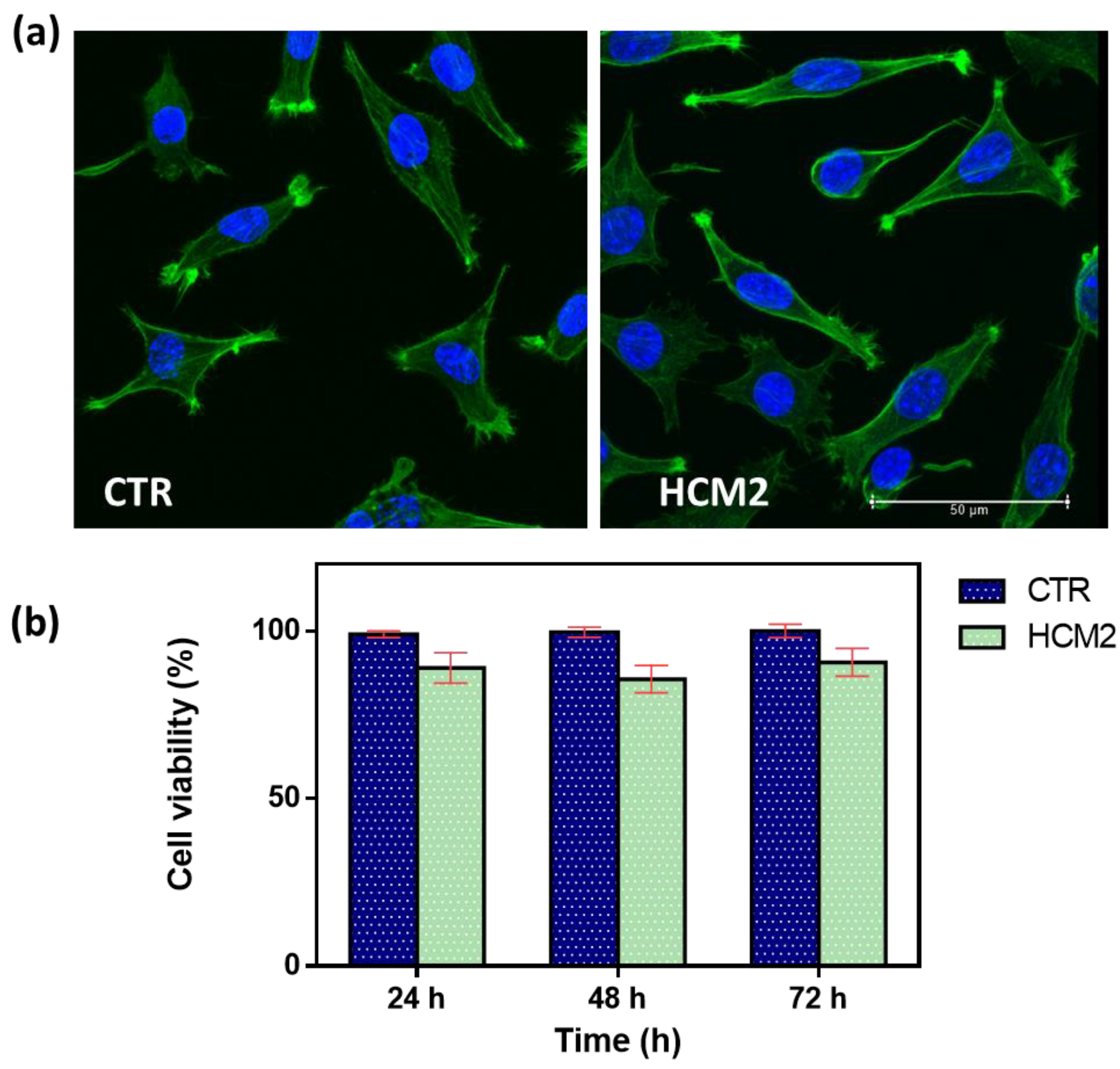
| Sample | C HA (mg/mL) | C BDDE (µL/mL) | NaOH% | T, °C | Time, h | SR (w/w) |
|---|---|---|---|---|---|---|
| HA1 | 133.3 | 8.33 | 1 | 25 | 24 | 80 |
| HA2 | 133.3 | 8.33 | 1 | 50 | 2 | 54 |
| Sample | 1 Hz | 10 Hz | ||
|---|---|---|---|---|
| G′ (Pa) | tanδ (-) | G′ (Pa) | tanδ (-) | |
| HA1 | 310 ± 30 | 0.5 ± 0.02 | 420 ± 30 | 0.52 ± 0.02 |
| HA2 | 640 ± 40 | 0.4 ± 0.02 | 1050 ± 40 | 0.32 ± 0.02 |
| CMC1 | 130 ± 30 | 0.4 ± 0.02 | 220 ± 30 | 0.35 ± 0.02 |
| CMC2 | 55 ± 30 | 0.7 ± 0.02 | 120 ± 30 | 0.52 ± 0.02 |
| Sample | C CMC (mg/mL) | C BDDE (µL/mL) | NaOH% | T, °C | Time, h | SR (w/w) |
|---|---|---|---|---|---|---|
| CMC1 | 133.3 | 8.33 | 1 | 25 | 24 | 90 |
| CMC2 | 133.3 | 8.33 | 1 | 50 | 2 | 18 |
| Sample | HA/CMC Weight Ratio | C HA (mg/mL) | C CMC (mg/mL) | C BDDE (µL/mL) | T (°C), | Time (h) | SR (w/w) |
|---|---|---|---|---|---|---|---|
| HCM1 | 3/1 | 100 | 33.3 | 8.33 | 25 | 24 | 58 |
| HCM2 | 1/1 | 66.6 | 66.6 | 8.33 | 25 | 24 | 76 |
| HCM3 | 1/3 | 33.3 | 100 | 8.33 | 25 | 24 | 50 |
| Sample | 20 °C, 1 Hz | 20 °C, 10 Hz | 37 °C, 1 Hz | 37 °C, 10 Hz | |||
|---|---|---|---|---|---|---|---|
| G′ (Pa) | tanδ (-) | G′ (Pa) | tanδ (-) | G′ (Pa) | tanδ (-) | G′ (Pa) | |
| HCM1 | 1700 ± 130 | 0.13 ± 0.03 | 2000 ± 120 | 0.13 ± 0.02 | 1100 ± 200 | 0.19 | 1400 ± 200 |
| HCM2 | 1900 ± 100 | 0.15 ± 0.05 | 2300 ± 100 | 0.2 ± 0.04 | 1800.0 ± 200 | 0.14 | 2200 ± 100 |
| HCM3 | 380 ± 90 | 0.25 ± 0.05 | 510 ± 150 | 0.25 ± 0.03 | 360 ± 120 | 0.2 | 500 ± 100 |
| Sample | 20 °C, 1 Hz | 37 °C, 1 Hz | ||||
|---|---|---|---|---|---|---|
| G′ (Pa) | tanδ (-) | G′/G′AC (-) | G′ (Pa) | tanδ (-) | G′/G′AC (-) | |
| HCM1 | 550 ± 90 | 0.15 ± 0.03 | 3.1 | 550 ± 110 | 0.13 ± 0.04 | 2.1 |
| HCM2 | 870 ± 120 | 0.13 ± 0.05 | 2.2 | 800 ± 150 | 0.09 ± 0.02 | 2.3 |
| HCM3 | 140 ± 90 | 0.30 ± 0.02 | 2.7 | 190 ± 90 | 0.30 ± 0.03 | 1.9 |
Disclaimer/Publisher’s Note: The statements, opinions and data contained in all publications are solely those of the individual author(s) and contributor(s) and not of MDPI and/or the editor(s). MDPI and/or the editor(s) disclaim responsibility for any injury to people or property resulting from any ideas, methods, instructions or products referred to in the content. |
© 2024 by the authors. Licensee MDPI, Basel, Switzerland. This article is an open access article distributed under the terms and conditions of the Creative Commons Attribution (CC BY) license (https://creativecommons.org/licenses/by/4.0/).
Share and Cite
Della Sala, F.; di Gennaro, M.; Makvandi, P.; Borzacchiello, A. A Covalently Cross-Linked Hyaluronic Acid/Carboxymethyl Cellulose Composite Hydrogel as a Potential Filler for Soft Tissue Augmentation. Gels 2024, 10, 67. https://doi.org/10.3390/gels10010067
Della Sala F, di Gennaro M, Makvandi P, Borzacchiello A. A Covalently Cross-Linked Hyaluronic Acid/Carboxymethyl Cellulose Composite Hydrogel as a Potential Filler for Soft Tissue Augmentation. Gels. 2024; 10(1):67. https://doi.org/10.3390/gels10010067
Chicago/Turabian StyleDella Sala, Francesca, Mario di Gennaro, Pooyan Makvandi, and Assunta Borzacchiello. 2024. "A Covalently Cross-Linked Hyaluronic Acid/Carboxymethyl Cellulose Composite Hydrogel as a Potential Filler for Soft Tissue Augmentation" Gels 10, no. 1: 67. https://doi.org/10.3390/gels10010067
APA StyleDella Sala, F., di Gennaro, M., Makvandi, P., & Borzacchiello, A. (2024). A Covalently Cross-Linked Hyaluronic Acid/Carboxymethyl Cellulose Composite Hydrogel as a Potential Filler for Soft Tissue Augmentation. Gels, 10(1), 67. https://doi.org/10.3390/gels10010067








